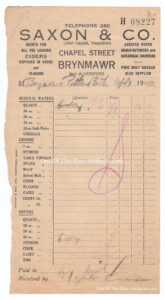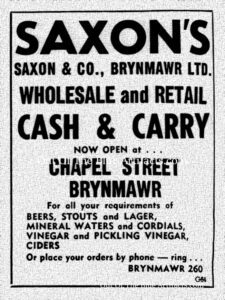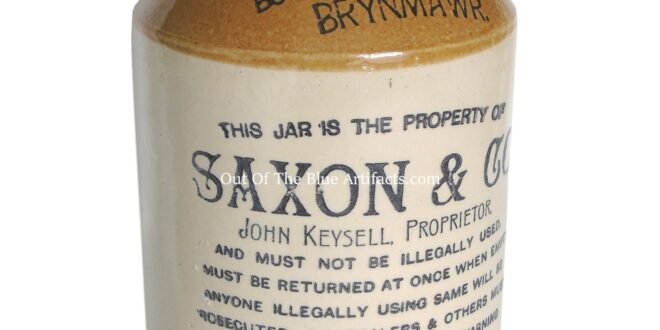Saxon & Co Botanical Brewers of Brynmawr.
The Saxon company began with Mr Edwin Saxon (1858-1931) of Middleton, Lancashire, England and his wife Mrs Emma Saxon nee Howarth (1858-1929) of Heywood, Lancashire, England. The couple married in 1884.
Mr Edwin Saxon was the son of Mr Henry Saxon (1821-1905) and Mrs Mary Saxon nee Howarth (1827-1897) of Middleton, St Leonard, Lancashire, England, Henry was an agricultural labourer and coal merchant.
Henry and Mary Saxon.
Henry and Mary Saxon had six children – Miss Anne Saxon (1852-????). Miss Emma Saxon (1853-????). Miss Alice Saxon (1855-????). Mr Edwin Saxon (1858-1931). Mr Thomas Saxon (1860-1914). Mr William Saxon (1864-1925): Messrs Edwin, Thomas and William Saxon all ventured into the Botanical Brewing trade which can be seen in detail below.
Mr Edwin Saxon at Manchester Road, Haywood, Lancashire, England.
On the 1891 census, Edwin and Emma Saxon were living at 26 Manchester Road, Haywood, Lancashire, England. Edwin Saxon was listed as a bookkeeper.
Mr Edwin Saxon at Upper Forster Street, Hatherton, Walsall, Staffordshire.
On the 1901 census, Edwin and Emma Saxon were living at 21 Upper Forster Street, Hatherton, Walsall, Staffordshire. Edwin Saxon was listed as a botanic beer brewer and an employer and Emma was listed as a botanic beer bottler.
Mr Thomas Saxon.
Mr Thomas Saxon (1860-1914) Edwin Saxon’s brother, was a Botanical Brewer. On the 1901 census he was living at 104 Pool Street, Wolverhampton, Staffordshire, England. He was at the address with his wife Mrs Rose Saxon nee Wellings and their children.
Mr William Saxon.
Mr William Saxon (1863-1925), Edwin Saxon’s brother, was a Botanical Brewer. On the 1911 census he was living at 62 Mary Street, Balsall Heath, Birmingham. Mr William Saxon, born in 1864 (his date of birth was misprinted on the census sheet) at Heywood, Lancashire, England. His wife was Mrs Mary Saxon nee Keysell, born 1881 at Ludlow, Shropshire. They married in 1901 and had a daughter Miss Edith A. Saxon, born in 1902 at Wolverhampton, Staffordshire. (Mary Keysell was John Keysell’s sister).
Mr Edwin Saxon at Ynysgau Street, Merthyr, South Wales.
On the 1911 census, Edwin and Emma Saxon were living at 31 Ynysgau Street, Merthyr. Edwin Saxon was listed as a brewer of non-intoxicating drinks and Emma Saxon was listed as an assistant in the above business. Also living at the same address were – Mr William Howarth, brother-in-law, an assistant in the business and Mr John Keysell, a carter and salesman in the same business, delivering non-intoxicating drinks to customers.
Mr John Keysell.
Mr John Keysell (1884-1966) of Ludlow, Shropshire, England, was a carter and salesman working for Mr Edwin Saxon at Merthyr, as seen above.
In 1912, Mr John Keysell married Miss Rose Annie Jones (1888-1969) of Burslem, Staffordshire, England. In 1911, Miss Rose Annie Jones was working as a servant for Miss Jemima Lewis and her sisters at Penydarren Park, Merthyr.
Mr John Keysell at Brynmawr.
In 1915 Mr John Keysell and his wife Annie Keysell came to Brynmawr.
 Saxon & Co at Chapel Brynmawr.
Saxon & Co at Chapel Brynmawr.
On Thursday 5th of September 1918, the South Wales Daily News reported on a premises in Chapel Street, Brynmwr, comprising a botanical brewery and stables, let to the Brynmawr District Council, was sold to Messrs Saxon & Co, tenants for £250. This suggests, either Saxon & Co had already set up business there and it was officially sold by the council to the company at this date, or the company had acquired the premises that had been previously used as a botanic brewery by another company that had vacated the building?
By the mid 1920’s, John and Rose Keysell had three sons – Mr Kenneth Francis Keysell (1917-1995) and Albert James Keysell (1918-1996) and Stanley Keysell (1923-????) and a daughter Miss Mary Keysell (1921-????).
Saxon & Co at Hereford.
While at Brynmawr, the Saxon Company also had a branch at Hereford.
Messrs Kenneth and Albert Keysell.
Throughout the 1950’s and 1960’s the Saxon company at Brynmawr was being managed by Mr John Keysell’s sons, Mr Kenneth Francis Keysell and Albert James Keysell, who were both partners in the company.
Bankruptcy Notice.
On March the 7th 1969, the London Gazette issued a notification that Saxon & Co of Brynmawr was dissolved. Mr A. J. Keysell was stated as being the director of the company.
Liquidation and Sale Of Machinery.
On Tuesday 15th of April 1969, the Bristol Evening Post printed – By order of the voluntary liquidator of the established firm of Saxon & Co, Mineral Water Factory of Brynmawr. Eric Thomas & Harpur, Auctioneers and Valuers have been favoured with instructions to sell by tender, the contents of the above factory.
The equipment and machinery advertised as for sale were as follows – Labelling Machine Banks B.L.M. 2 Meadowcroft Fastafil, Filling Machines. A Meadowcroft Carbonator. A British Million Hydro Bottle Washer. Two Syrup Crown Filling Machines. An Ingersol Rand Compressor and Fitments. 2.6 Gallon Stainless Steel Pans. 1.6 Gallon Sugar Mixer. A quantity of Dexion Shelving and 3 Karrier Bantam L.W.B., three-ton lorries.
Winding Up Order.
On the 15th of January 1971, the London Gazette issued notice that the firm of Saxon & Co, Brynmawr, following a winding up order the property had been disposed of.
 Saxon’s Cash & Carry.
Saxon’s Cash & Carry.
On Friday 27th of October 1972, the Gwent Gazette printed advertisements (as seen right) stating that Saxon & Co, Brynmawr Ltd was now open at Chapel Street, Brynmawr. They were advertised as being a wholesale and resale cash and carry. They sold beers, stouts, and lager, mineral waters, cordials, vinegar and pickling vinegar and ciders. Tel – Brynmawr 260.
Canvassers Wanted.
In the same issue of the Gwent Gazette of October 1972, in the jobs section, ladies were wanted as house-to-house canvassers to work for Saxon of Brynmawr, for sales of their mineral waters, beers and ciders.
The Closure of the Saxon Cash & Carry.
As of yet, I cannot find a date or reason for the closure of the Saxon Factory and Cash and Carry premises at Chapel Street, Brynmawr.
H. & J. Thompson.
In February 1977, it was stated that the old Saxon Pop Factory, which was owned by a Mr Procter of the Isle of Man was being rented by Messrs J. & H. Thompson.
On Thursday 17th of March 1977, the Gwent Gazette reported that J. & H. Thompson, a car firm were planning on moving to the old Saxon Pop Factory. Their head office was stated as being at the old Emporium at Worcester Street, Brynmawr.
Opposition to the Car Firm.
On Thursday 21st of April 1977, the Gwent Gazette reported on a group of mothers who were fighting to stop the car repair works being set up at the old Saxon Pop Factory near their home at Brynmawr. The newspaper said they had won the first round in their opposition battle. Apart from various adverts printed in papers throughout 1977, nothing more was reported on the future of the car firm based at the old factory.
Kendai Rubber Reclamations Ltd.
In 1978, Kendai Rubber Reclamations Ltd were based at the former Saxon Pop Factory at Brynmawr. It was mentioned in one report that the Managing Director was a Mr Brynley Morris, the company had a workforce of between 30 and 40 people working during the summer months with five full time workers and 15 casual workers.
Throughout the year many concerns were raised over threats of rubber tyre mountains with many objecting to the hazardous nature of the business in relation to its location in a built up area.
In October 1978, Kendai Rubber Reclamations Ltd were asked to move onto the industrial site at Brynmawr. This request came after there were issues about the safety of the residents in close proximity after a fire that broke out at the premises in June 1978.
The Land for Housing Purposes Proposal.
After the safety concerns were raised after the fire at Kendai Reclamations Ltd and the request to move to the industrial estate, the council asked the Gwent County Council to include a proposal for the land in question, so as they can designate it for housing purposes.
Licence Extended.
Even though there was much opposition to the reclamation plant, in April 1979 the council extended the licence to Kendai Rubber Reclamations to remain at the premises for another twelve months. The reclamation plant was not mentioned after this date.
Saxon & Co Dissolved.
In 1980, the London Gazette printed notification that the firm of Saxon & Co, Brynmawr was dissolved.
The Future of the old Saxon Factory.
On Thursday 4th of November 1982, the Gwent Gazette reported on the future plans of the former Saxon Pop Factory at Brynmawr to be used for carpentry, warehousing and printing computer forms. It was stated that a Mr John Tidswell Chew of Worcester Street, Brynmawr had applied to Blaenau Gwent Borough Council for multiple purpose use of the old Saxon Pop Factory in Chapel Street. Local councillors wanted the site for homes for the elderly but it was stated that there was no money available.
The Demolition of the Saxon Factory.
On Thursday 18th of November 1982, just two weeks after the councils statement that there was no money available for the planning of houses for the elderly, the Gwent Gazette reported that the Blaenau Gwent Borough Council were thinking of spending about £18,000 on buying and then demolishing the old Saxon’s Pop Factory in Brynmawr. The purchase price would be £12,000 with demolition in the region of £6,000. This was part of the sheltered housing scheme mentioned in the late 1970’s.
The Sheltered Housing Scheme.
On Thursday 5th of May1988, the Gwent Gazette reported the Borough Council is negotiating with housing associations for work on three sheltered housing schemes in Blaenau Gwent. They include – twenty-five units in Charles Street, Tredegar, thirty-one units at Rees and Williams Street, Ebbw Vale and thirty-two units at the former Saxon Pop Factory site in Brynmawr.
Saxon Court.
In 1988, the sheltered housing association planned on building Saxon Court, a thirty-two unit housing complex at the former Saxon Pop Factory site in Brynmawr. Later in the year, it was reported that building work had been delayed.
In February 1991 work was underway and Saxon Court was finally completed in 1992. The finished premises consisted of 31 apartments over 3 floors.
Source – South Wales Gazette, London Gazette, Bristol Evening Post, Ancestry and Gwent Gazette.
 Out Of The Blue Artifacts A Library of a lifetime of collecting
Out Of The Blue Artifacts A Library of a lifetime of collecting
